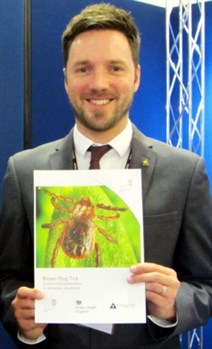Ticks that live indoors, hiding in skirting boards and soft furnishing just like bed bugs, have already been found in the UK. The brown dog tick (Rhypicephalus sanguineus) was identified as one of the emerging public health pests in the Jonathan Peck Memorial Lecture on 21 October.
The 2015 Jonathan Peck Memorial Lecture was given by Dr Jolyon Medlock, head of medical entomology and zoonoses at Public Health England. The lecture kicked off the second day of the Chartered Institute of Environmental Health (CIEH) 115th National Conference which was held at the East Midlands Conference Centre on the University of Nottingham campus on 20 and 21 October.
| Dr Medlock’s subject was Emergent public health challenges from vectors. He tracked the rising threat from a variety of invasive mosquito species (in particular Aedes albopictus, Aedes aegypti and Aedes japonica) and questioned whether the UK’s local authority sector had the capacity to deal with such pests; all of which have significant implications for public health because of the diseases they carry. Of particular concern is Aedes albopictus, the Asian Tiger mosquito, which is now well established in the EU and is spreading rapidly. For example, it is now established across the whole of Italy. It has also been found in Northern France and climate change predictions suggest southern England will soon be a suitable habitat. |
|
|
He explained that reports of nuisance biting in the UK have already increased 2.5 times since the 1990s. But it’s not nuisance biting that is of most concern, it’s the disease transmission capability of mosquitoes as vectors of things like dengue and chikungunya. Jolyon went through plenty of data on how the number of cases of these diseases, acquired locally in Europe, are also increasing. Taking a Mediterranean holiday might already bring with it risks that we usually associate with more exotic locations! But what of those indoor ticks? The kennel or brown dog tick (Rhypicephalus sanguineus) is found globally, although in Europe it is still mainly confined to the Mediterranean basin. It is a vector of three diseases Babesiosis, a malaria-like disease Erlichiosis, a bacterial infection of the white blood cells and Mediterranean spotted fever. While, as its name suggests, the brown dog tick is primarily a parasite of dogs, it is also known to bite people. Because it’s happy to live indoors, hiding way just like bedbugs in soft furnishings, skirting boards and the like and because it can survive for 18 months without a blood meal with females laying up to 4,000 eggs, it is likely to prove a challenging pest to control. Rhypicephalus sanguineus is a non-native species which is thought to be coming into the country through two main routes, as Jolyon explained. The first is because of the pet passport system which has increased the numbers of travelling pets. More specifically, changes to the passport introduced in 2012 removed the requirement for travelling pets to undergo tick treatment. The second route is the increased international trade in puppies, especially the illegal trade now increasingly using social media and particularly Facebook, making it extremely difficult to police. Such is the concern about the rise in brown dog tick infestations in the UK that CIEH’s National Pest Advisory Panel (NPAP) has published a new information leaflet on its control and prevention. Download the Brown tick leaflet from the Pest library or from the CIEH website. Dr Medlock’s presentation was the second Jonathan Peck Memorial Lecture which has been established by CIEH in recognition of the exceptional contribution that Jonathan made to pest management and public health. Introducing the session CIEH chief executive Graham Jukes praised Jonathan for his generosity and campaigning attitude. His legacy continues in many ways. This lecture is but one of them. |
|
|
| The lecture was sponsored by the Killgerm Group.
The CIEH national conference attracted some 270 delegates from local authorities across the country as well as academics, blue chip companies from the food and retail sector and businesses providing public health related services to local authorities. |
||



 Dr Jolyon Medway, right, with session chairman and CIEH chief executive, Graham Jukes
Dr Jolyon Medway, right, with session chairman and CIEH chief executive, Graham Jukes 